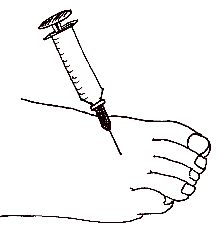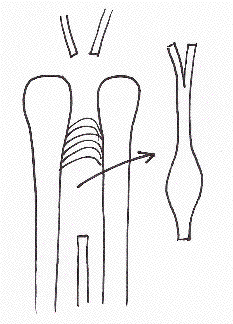Morton's neuroma
Many people suffer from chronic forefoot overload. The causes are many, we can mention in particular:
ankle stiffness, especially if the Achilles tendon is shortened
wearing high heels for a long time
excess weight
hereditary factors
This overload can lead to different problems, including hallux valgus and claw toes.
Sometimes this overload affects the nerves that run in the sole of the foot, between the metatarsal bones:

on the right image, we see on the left a normal plantar nerve, which passes in a small fibrous "tunnel" between two metatarsals; on the right, on the other hand, the nerve is enlarged and no longer functions properly, because the tunnel has become too narrow. It is this swelling of the nerve that is called the neuroma.
Symptoms
Patients suffering from Morton's neuroma complain of pain under the forefoot at a specific point, sometimes accompanied by tingling in the neighboring toes; some have the sensation of having a "lump" under the foot. The pain is usually aggravated by tight shoes, and after long walks.
Processing
Brackets
The treatment is first of all simple: it is absolutely necessary to try to wear plantar supports for a few months, which support the foot a little behind the normal points of support, and thus relieve the forefoot of part of the body weight. This treatment can reduce or even eliminate the pain if it is not too severe, or if it has not been present for a long time.
Infiltration
If the pain continues despite the plantar supports, we can try an infiltration: this involves injecting a small amount of cortisone around the neuroma.

cortisone, a powerful anti-inflammatory, can reduce pain and inflammation.
Transaction
When the so-called "conservative" treatments have failed, surgical treatment is a good option: the operation is simple, it consists of removing the nerve which is degenerative and no longer functions correctly. This removes the cause of the problem. There is a relative drawback: the sensitivity of the responding surfaces of the 2 toes concerned decreases or even disappears following the operation.
The operation can be done dorsally or plantarly. It is usually done on an outpatient basis.

On the diagram above, we can see which part of the nerve is removed during the operation. Walking rehabilitation is simple, there is usually no need for physiotherapy. Pressing on the forefoot is painful at first, sometimes requiring the use of an English cane for a few days. The pain then gradually decreases over several weeks.


